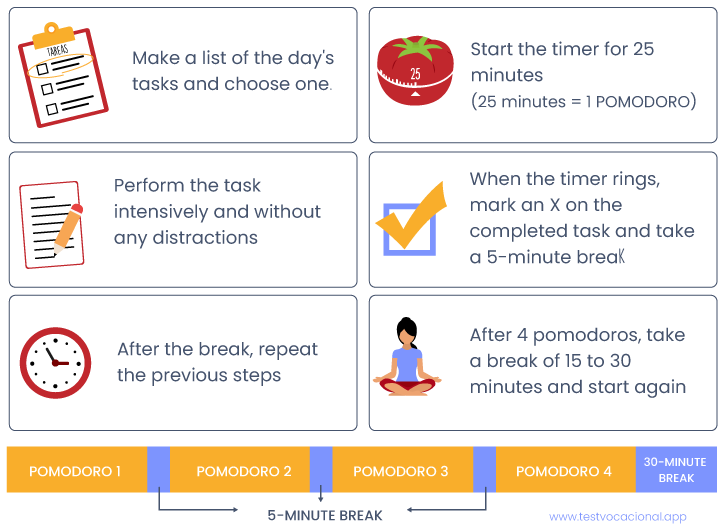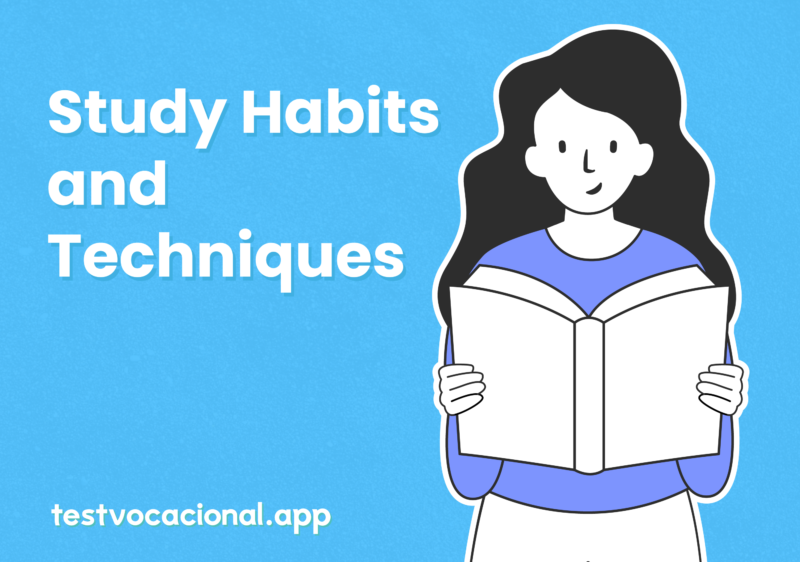What is the Pomodoro Technique?
The Pomodoro Technique is a method developed by Francesco Cirillo in the late 1980s to improve time management by breaking work into smaller chunks. This technique allows you to understand how much time each task actually takes, making you more aware of how you use your time. It’s a great way to boost productivity because studying intensively and without distractions makes study time much more effective. Additionally, taking short breaks frequently helps you stay focused during periods of high activity, improving your performance.
How does the Pomodoro Technique work?
To use this technique, you must use a timer to divide your time into 25-minute intervals of focused activity, called pomodoros, followed by 5-minute breaks, with longer 30-minute breaks after every four pomodoros.
Steps of the Pomodoro Technique

- Make a list of daily tasks and choose one activity to work on.
- Set the timer for 25 minutes.
- Work intensively on the task until the timer rings. One of the main goals of this technique is to eliminate interruptions, whether from yourself or others (you can quickly jot them down to address later). A pomodoro cannot be paused or divided; if an interruption cannot be postponed, the pomodoro is canceled and restarted later.
- Mark the completed task on your list. Keeping track of completed tasks gives you a sense of achievement. It also serves as a database for later reflection and improvement.
- Take a 5-minute break. These short pauses help maintain focus and make work more sustainable. The satisfaction of successfully completing a task without distractions will motivate you to continue and increase productivity.
- Repeat the previous steps. After four pomodoros, take a longer 20-30 minute break. This helps you disconnect from the task and clear your mind. Use this time to take a walk, have a coffee, or chat with a friend. Resting allows you to perform at your best when you return to work.
Pomodoro Technique Timings
Implementing the Pomodoro Technique is not difficult; you just need some time to adjust and break old habits. Like any other technique, it can be adapted to individual needs. If 25 minutes feels too long or too short based on your endurance or the type of task, you can try 10-minute or 30-minute intervals. Similarly, you can experiment with different break durations until you find what works best for you.

Advantages of the Pomodoro Technique
- Boosts productivity.
- Helps you get started with tasks.
- Prevents multitasking, keeping you 100% focused on one activity.
- Enhances concentration, as you have a set 25-minute period to focus on a specific task.
- Helps you stay organized and learn to prioritize.
- Forces you to take breaks.
- Sometimes, stepping away from a task briefly helps you find a solution. These breaks act as those essential moments of clarity.
- Helps you track the time spent on each subject or task.
- Makes it easier to break tasks into smaller, manageable chunks.
- Establishes time limits for tasks that tend to drag on unnecessarily.
Disadvantages of the Pomodoro Technique
- You cannot stop in the middle of a task for the technique to work properly.
- It’s difficult to apply to group work or study sessions.
- It may not be suitable for creative tasks, as creativity often requires uninterrupted time to let ideas flow freely.
If you want to learn more study techniques, we invite you to read our article: The Top 5 Study Techniques.


